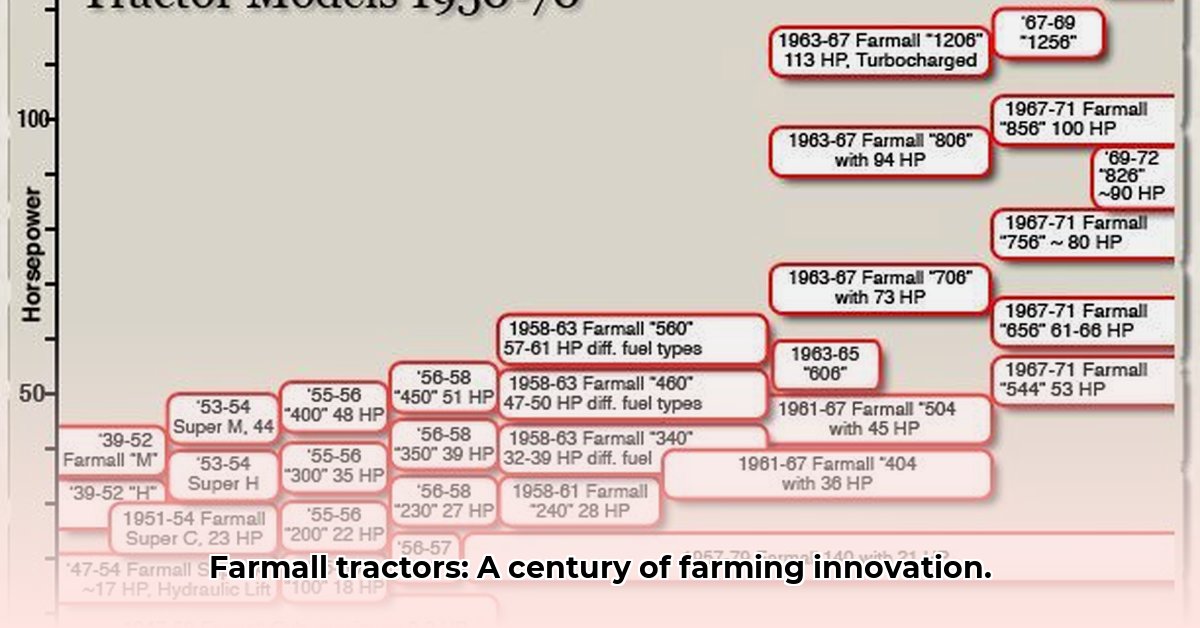
Imagine a world before tractors, where farming was backbreaking toil. Then picture the Farmall arriving—a game-changer that revolutionized food production. This article traces the Farmall tractor's evolution, from its humble beginnings to its modern iterations, highlighting its impact on farming practices and its evolving relationship with sustainable agriculture. We'll explore key model improvements, analyze its environmental footprint, and speculate on the brand's future. For more detailed specifications on various Farmall models, check out this useful resource.
Before the Farmall: International Harvester's Early Efforts
Before the Farmall became synonymous with agricultural innovation, International Harvester (IH) produced earlier tractors. While data on these predecessors is scarce, their existence is crucial to understanding the Farmall's transformative impact. These early machines, though less efficient and more cumbersome, laid the groundwork for the revolutionary designs to come. They were the experimental forerunners, paving the way for something truly remarkable.
The Farmall Revolution: A Tricycle Redraws the Landscape (1924-1930s)
1924 marked a watershed moment. IH introduced the Farmall, a revolutionary machine that redefined farming. Its innovative tricycle design—two large rear wheels and a smaller front wheel—allowed for unparalleled maneuverability in tight crop rows. This wasn't simply a technological leap; it represented a cultural shift. The early Farmall models, such as the F-12 and F-20, symbolized this new era, significantly impacting farming efficiency. How did this simple design change everything? By dramatically reducing soil compaction and improving crop yields.
Refining the Farmall: Decades of Enhancement (1940s-1960s)
Following the Farmall's debut, IH relentlessly refined its designs. Each model year brought improvements in horsepower, engine technology, and ease of use. Think of it as an iterative process, with each generation building upon the successes (and learning from the shortcomings) of its predecessors. The highly popular Farmall H, for example, exemplified this commitment to continuous improvement. This constant evolution transformed farming from labor-intensive to mechanized, driving yields and efficiency upward. What were the specific engine improvements that drove this increased productivity? The shift from carburetors to more efficient fuel injection systems is one major example.
The Farmall's Legacy and Resurgence (1970s-Present)
The original Farmall production line concluded in 1975. However, the brand's legacy—a symbol of innovation and efficiency—persisted. Case IH, born from a merger involving IH, recognized the Farmall's enduring appeal and revived the name, primarily focusing on utility tractors. This speaks volumes about the deep impact of the Farmall on farming culture. The Farmall name continues to resonate as a symbol of progress and excellence in agriculture. What factors contributed to this successful brand revival? The inherent trust and positive reputation associated with the name was undoubtedly a key factor.
Farmall Tractors and Sustainable Agriculture: A Complex Relationship
While mechanized farming significantly boosted productivity, it also introduced challenges. Increased fuel consumption and soil compaction were major concerns. Yet, modern Case IH tractors, including the updated Farmall models, are actively addressing these environmental issues. Improvements in fuel efficiency, advanced emission controls, and precision agriculture techniques are crucial for balancing progress with environmental responsibility. Did increased horsepower necessarily mean an increase in overall environmental impact? No, advancements in engine technology and fuel efficiency have enabled increased power with less impact over time.
A Century of Innovation: Key Farmall Models
Here's a concise overview of significant Farmall models and their contributions:
| Year Range | Model(s) | Key Features | Impact |
|---|---|---|---|
| 1924-1930s | Farmall F-12, F-20 | Tricycle design, improved maneuverability | Revolutionized row-crop farming |
| 1940s-1950s | Farmall H | Increased horsepower, upgraded features | Greater efficiency, wider adoption |
| 1960s-1970s | Various Models (e.g., 140) | Ongoing refinements and improvements | Enhanced productivity, industry standardization |
| Present | Case IH Farmall Series | Modern features, fuel efficiency improvements, focus on sustainability | Sustainable practices focus; ongoing development |
The Farmall story isn't just about machines; it's a testament to human ingenuity, adaptation, and the ongoing pursuit of a sustainable food system. The future of the Farmall brand, and sustainable farming itself, remains a compelling narrative yet to be fully written.
Reducing the Environmental Impact: A Path Forward
Key Takeaways:
- The Farmall's legacy reflects both the benefits and challenges of mechanized agriculture.
- The evolution of engine technology has been a cornerstone of environmental progress.
- Modern farming practices, such as precision agriculture, contribute to sustainability.
- Biofuels and other alternative energy sources offer promising avenues for a greener future.
- Sustainability in agriculture relies heavily on technology and collaborative efforts.